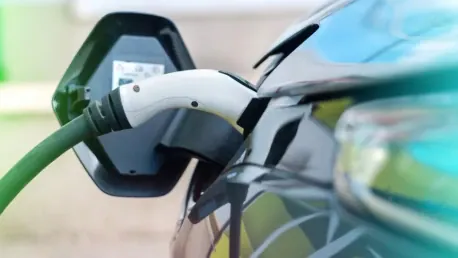India is rapidly accelerating towards embracing electric vehicles (EVs), significantly impacting urban planning and infrastructure development. Aiming to become the world’s largest EV market by 2030, India is reimagining traditional transportation and aligning policies with sustainable mobility solutions. This remarkable transformation demands concerted efforts from government bodies, the private sector, urban planners, and consumers to create a cohesive, efficient, and environmentally friendly transportation system that promises a sustainable future for India’s urban landscapes.
Unprecedented Growth of India’s EV Market
The electric vehicle market in India is on an unprecedented growth trajectory, with projections indicating a profound expansion in the coming years. According to Wright research, the market is expected to rise at a Compound Annual Growth Rate (CAGR) of 22.4%, leaping from $23.38 billion in 2024 to a formidable $117.78 billion by 2032. This significant growth is driven by an increasing number of electric scooters, bikes, and cars, fueled by factors like environmental consciousness, government initiatives, and changing consumer preferences that reflect a broader shift towards sustainable living.
Key government initiatives are playing a pivotal role in this journey toward widespread electrification. The National Electric Mobility Mission Plan and the Faster Adoption and Manufacturing of (Hybrid &) Electric Vehicles (FAME) scheme are among India’s strategic policies aimed at bolstering EV adoption. For instance, the FAME initiative, which includes substantial financial investments, plays a crucial role in scaling up EV infrastructure, highlighting proactive measures by the government to enhance this least-polluting mode of transportation. By fostering an environment conducive to EV growth, these initiatives are instrumental in driving India towards its ambitious goals.
Impact on Urban Development
Urban development is experiencing direct ramifications from the rise of EVs, transforming the landscape of cities across India. With increasing urbanization come challenges such as traffic congestion, air pollution, and noise pollution, which conventional transportation solutions exacerbate. The integration of EVs into future smart cities and urban planning is increasingly recognized as a solution to these pressing issues. Present-day residential and commercial projects are embedding EV charging infrastructure into their designs. New housing complexes, malls, and office buildings are incorporating dedicated spaces for EV chargers, reflecting the growing consumer demand for such amenities and an expectation for eco-friendly transportation options.
Countries like Norway and China have set precedents in this area, having comprehensively integrated EVs into urban planning by significantly investing in public chargers and implementing favorable policies to make EVs financially appealing. India, too, is following in these footsteps, with 12,146 operational public charging stations, predominantly in Maharashtra and Delhi. This represents a 640% increase from the previous two years, indicating rapid development and public adaptation. This robust infrastructure is a testament to India’s commitment to creating an environment that supports and sustains EV usage on a large scale.
Remodeling Traditional Infrastructure
The upward trend in EV adoption necessitates remodeling traditional infrastructure such as parking facilities to include EV charging provisions. This development not only benefits EV users by providing necessary charging points but also reflects broader urban planning efforts to modernize transportation infrastructure comprehensively. Moreover, incorporating smart technologies—like real-time data tracking of available charging stations—helps manage the EV network efficiently, thus enhancing user experience and operational efficiency. This innovative approach ensures that the infrastructure evolves in tandem with the growing demand for electric vehicles.
Public transportation is another sector witnessing a profound shift towards electrification. China leads the way with over 90% of the world’s electric buses and trucks, as reported by the International Council on Clean Transportation. India’s urban planners are encouraged to follow suit by integrating electric buses and other EVs into public transit systems. Such initiatives are poised to substantially reduce emissions and fossil fuel dependency while also promoting a cleaner and more sustainable public transportation system. Supporting infrastructure, such as bus depots and transit route charging stations, will be critical to this shift, heralding a new era in public transportation.
Addressing Challenges in EV Infrastructure
Despite these advances, significant challenges persist, primarily due to the current insufficient ratio of charging stations to electric vehicles in India. According to the Federation of Automobile Dealers’ Association (FADA), the ratio stands at 1:135, contrasting starkly with the global benchmark of 1 charging station per 6-20 EVs. To counter this disparity, the installation of additional charging stations is necessary. The government has greenlit the sanctioning of 2,877 more charging stations, but scaling these efforts remains crucial. Fast-charging technologies play a vital role by reducing charging times, making long commutes viable, and overall diminishing the need for numerous stations.
Integrating technology into EV infrastructure is essential for both efficiency and user satisfaction. Smart charging stations, capable of communicating with EVs, monitoring energy consumption, and providing real-time updates, stand as the future of this infrastructure. Additionally, utilizing renewable energy sources for charging stations will amplify the reduction of environmental impact, aligning energy consumption with sustainable practices. This forward-looking approach ensures that the ecosystem around EVs remains efficient, sustainable, and user-friendly, fostering broader acceptance and adoption among consumers.
Role of the Private Sector and Public-Private Partnerships
India is swiftly moving toward the widespread adoption of electric vehicles (EVs), which is dramatically influencing urban planning and infrastructure development. With a goal to become the largest EV market in the world by 2030, India is overhauling traditional transportation methods in favor of eco-friendly mobility solutions. This significant shift requires a unified effort from government agencies, private companies, urban planners, and the public to establish a transportation system that is efficient, integrated, and sustainable. By focusing on electric mobility, India aims to reduce pollution, enhance energy security, and secure a greener future for its cities, which will lead to healthier and more livable urban environments. Efforts like building extensive EV charging networks, investing in battery technology, and providing incentives for EV adoption play crucial roles in this transformation. As India continues to innovate and align its policies towards environmentally conscious transportation, it sets a precedent for sustainable urban development globally.









